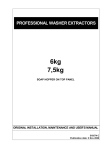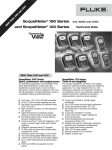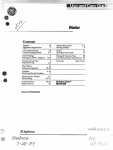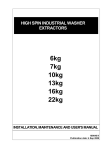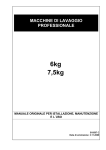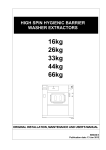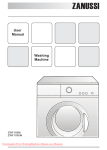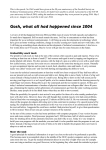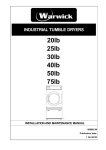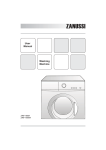Download Primus Operation – P6 P7
Transcript
PROFESSIONAL WASHER EXTRACTORS 6kg 7,5kg SOAP HOPPER ON FRONT PANEL INSTALLATION, MAINTENANCE AND USER'S MANUAL 502207 K Publication date: 18 Aug 2009 USER'S MANUAL 1. TABLE OF CONTENTS 1. TABLE OF CONTENTS ................................................................................................ 1 2. WARNINGS AND LABELS ........................................................................................... 2 2.1. INSTRUCTIONS FOR MAINTENANCE, ADJUSTMENT AND SAFETY OF PEOPLE .........................3 3. SYMBOLS ON THE MACHINE ..................................................................................... 4 4. OPERATION INSTRUCTIONS...................................................................................... 4 5. FIRST SERVICE AT TECHNICAL PROBLEM.............................................................. 6 502207_K_PUB_DATE_18_AUG_2009.DOC USER'S MANUAL 1 2. WARNINGS AND LABELS TO MINIMIZE THE RISK OF FIRE, INJURY BY ELECTRIC SHOCK OR SERIOUS INJURIES TO PEOPLE OR PROPERTY DAMAGE, PLEASE READ AND FOLLOW THE FOLLOWING INSTRUCTIONS: – This English version is original language version. Without this original version, these instructions are incomplete. – Before installation, operation and maintenance of the machine read carefully the complete instructions, i.e. this „Installation, maintenance and user's manual“, „Programming manual“ and „Spare parts manual“. The Programming manual and Spare parts manual are not delivered with a machine by default. You shall ask the supplier / manufacturer to obtain Programming manual and Spare parts manual. – Follow the instruction written in manuals and keep the manuals in a proper place by the machine for later use. – Do not bypass the safety instructions stated in the manual and warnings on the machine labels. – The machine is destined for a textile washing only. It is not allowed to wash objects which are not made of textile; these could damage the glass, rubber seals etc. and can cause damage or injuries. – Follow all valid basic safety rules and laws. – This machine must not be operated by children. Before starting and operating the machine make sure there are not any persons (children) or animals in the machine or in machine vicinity. – Do not operate the machine with broken / missing parts, opened covers, also do not operate a machine which was not installed and put in operation according to instructions stated in the „Installation manual“. – Do not tamper with the machine controls. – Do not touch the door glass before the washing cycle has been finished. Do not open the door before the drum rotation stops and water is drained off the drum! Do not open the soap hopper during the water filling! – Do not use cleaning aids which are destined for dry cleaning and substances damaging machine rubber seals. Do not use any flammable or explosive materials. Do not store any flammable materials near the machine. – The warranty of the machine cannot be accepted in case corrosion was caused by chlorine and chlorine compounds impact. – Keep the machine surface clean and free of flammable materials. – Under certain conditions, hydrogen gas may be created in the hot water system that has not been used for two or more weeks. Hydrogen gas is explosive. If the hot water system has not been used for such period open all hot water taps and let the water run out for few minutes. This will release any accumulated gas. As this gas is flammable, do not smoke or use open flames during this time. – During extracting, the machine produces an equivalent noise level which does not exceed the value of 70 dB (A). – Be informed about the location of the laundry main switch or other emergency electrical disconnection devices. – The electrical parts are still under tension even if the „ON/OFF“ switch is off. Take out the mains plug. The machine is only out of tension if the mains plug is taken out! Ö WASHING AND CLEANING DETERGENTS Always read carefully and follow the instructions for fabric, washing and cleaning substances from manufacturers. Heed all warnings. Store these materials out of the reach of children. Observe all warnings stated on containers and covers to avoide possible injuries and the linen or machine damage. We recommend to use only proper washing soaps (with reduced foaming). Do not overdose the soap amount indicated on its cover. Overdosing of washing soaps will cause an excesive foaming wich can have negative effects to washing and also can damage the machine. ! WARNING! IF THE INSTALLED APPLIANCE OPERATE WITH COIN, TOKEN OR SIMILAR OPERATION FOR USE IN SELF-SERVICE SITUATIONS, THEN THE OWNER-INSTALLER MUST PROVIDE A REMOTE-LOCATED EMERGENCY STOP DEVICE. THIS DEVICE MUST BE PLACED IN SUCH A WAY THAT IT IS EASY AND SAFELY ACCESSIBLE FOR THE USERS. THE EMERGENCY STOP DEVICE TAKES CARE THAT AT LEAST THE CONTROL CIRCUIT OF THE APPLIANCE IS INTERRUPTED. ! WARNING! DO NOT TOUCH THE DOORGLASS UNTIL CYCLE HAS BEEN COMPLETED. DO NOT OPEN DOOR UNTIL CYLINDER REMAINS STOPPED AND WATER HAS BEEN DRAINED FROM CYLINDER. DO NOT PUT ARTICLES SOILED WITH EXPLOSIF SOLVENTS AND/OR DANGEROUS CHEMICAL PRODUCTS IN THE MACHINE. THIS MACHINE SHOULD NOT BE USED BY CHILDREN. DO NOT LET CHILDREN PLAY IN, ON, OR AROUND THE MACHINE. BEFORE TURNING THE MACHINE „ON“, MAKE SURE THAT THERE ARE NO PEOPLE OR ANIMALS PRESENT IN OR AROUND THE MACHINE. 2 USER'S MANUAL 502207_K_PUB_DATE_18_AUG_2009.DOC WARNING! Always disconnect the washer from the electrical supply before attempting any service. The washer extractor is out of tension if the main plug is taken out or when the main supply is disconnected. When the main switch is turned off the inlet terminals of the machine main switch are still under current! ! WARNING! ORIGINAL OR IDENTICAL PARTS MUST BE USED FOR REPLACEMENT IN THIS MACHINE. AFTER SERVICING REPLACE AND SECURE ALL PANELS IN THE ORIGINAL WAY. TAKE THESE MEASURES FOR CONTINUED PROTECTION AGAINST ELECTRICAL SHOCK, INJURY, FIRE AND/OR PROPERTY DAMAGE. ! WARNING! LOOKING AT THE MACHINE FROM THE FRONT VIEW THE DRUM ROTATION DURING EXTRACTION MUST BE CLOCKWISE. 2.1. INSTRUCTIONS FOR MAINTENANCE, ADJUSTMENT AND SAFETY OF PEOPLE Some important information for the usage of the machine are not (or only partly) mentioned in this User´s Manual. Missing information is possible to find in Installation and Maintenance Manual, which is delivered with the machine. References to „Installation and Maintenance Manual“ according to norm EN ISO 10472-1: 1. Description of the safe work system when maintenance is performed / adjustment / and when eliminating defects – chapter 5 / 5 / 6 2. Description of qualities for ventilation – chapter 4 3. Procedures on searching for defects / cleaning / maintenance – chapter 6 / 5 / 5 4. Heat risks – chapter 3 5. Safety procedure on manipulation, installation and dismantling – chapter 4 References to „Installation and Maintenance Manual“ according to norm EN ISO 10472-2: 1. Maintenance of door blocking – chapter 5 2. Electric risks – chapter 2 3. Heat energy – chapter 3 4. Sight holes – chapter 3 5. Explosive atmosphere – chapter 2 6. Biological or chemical pollution of water – chapter 2 7. Maximal possible overspeed – chapter 3 502207_K_PUB_DATE_18_AUG_2009.DOC USER'S MANUAL 3 3. SYMBOLS ON THE MACHINE Danger, read and follow written instructions Caution, high power voltage, electrical devices Caution, increased temperature Caution, outlet of steam from the machine Caution, dangerous electrical tension, electric devices Program selection Prewash Remaining time of a program Main wash Switching on a program or allow advance * Rinse Temperature of washing * Spinning Opening the door End of program, you can take off the linen * Note: according to setting in programming mode 4. OPERATION INSTRUCTIONS Ö PRIOR TO WASHING The manufacturer bears no responsibility for textiles being damaged by improper washing technologies. The linen has to be assorted according to its type and a selected wash temperature. Empty all pockets; nails, pins, screws etc. could damage the linen and the machine. To achieve better washing results, mix large and small pieces and put the linen into the washer free and separated. 1. „Program/run“ mode push button 2. Switch of the machine 3. „F“ push button 4. „START“ push button 5. Door open push button 6. Label of wash programms 7. Wash program steps indicators 8. Wash program number indicator 9. Indicator of wash program remaining time 10. Indicator of wash bath temperature 11. Button for wash program selection 12. Soap hopper Ö OPERATING: 1. Switch on the machine by a switch (2) located on the left of the control panel 2. The programming switch (1) must stand into „Run-mode“: 3. Open the machine door by the push button (5). 4. Put linen in the washer. The machine capacity of linen must not be exceeded. 5. Close the door by pushing on the left side of the door till you hear a click. Watch your hands! 4 USER'S MANUAL 502207_K_PUB_DATE_18_AUG_2009.DOC 6. Choose a program by the push button (11) according to the degree of dirt and character of linen. Find the kind of progam on program label (6). 7. Pull out the soap hopper (12) and fill up the dispencer chambers according to the selected program: st – I chamber with a washing powder for prewash. nd – II chamber with a washing powder/liquid soap for main wash. rd – III chamber with a fabric softener or starch (liquid soap). Do not open the soap hopper during the water filling ! 8. Press the START button (4). The cycle indicators (7) show the current wash step. – the first digital line (8) shows number of program – the second digital line (9) shows the resting wash time – the third digital line (10) shows the washing temperature Before you push the „START“ button (4) there is a possibility to select the following functions by pressing the „F“ button (3): PREWASH, SOAK, DELAY TIME, ECONOMIC, NO SPIN, GENTLE WASHG, (see Programming manual „Easy Control“). Note: For locking a program mode, changing factory settings and possibilities of program changes and setup - see Programming manual. 9. When the door LED lights up you can open the door using the push button (5). 10. Remove the linen from the drum after finishing wash program. Ö WASHING PROGRAMS: 502207_K_PUB_DATE_18_AUG_2009.DOC USER'S MANUAL 5 5. FIRST SERVICE AT TECHNICAL PROBLEM IMPORTANT! TECHNICAL INTERVENTION ON THE WASHING MACHINE IS ONLY FOR QUALIFIED TECHNICIANS WITH SUFFICIENT TECHNICAL KNOWLEDGE OF THE „EASY CONTROL“ WASHING MACHINE. FAILURE 1: DRAIN FAILURE NOT FINAL SEQUENCE Failure 1 occurs when the electronic timer detects that the water is not drained after 3 minutes in a drain or spin step. The failure message is displayed at the end of the cycle. DIAGNOSE: 1. Check the drain tube of the washing machine. 2. Check the drain valve. 3. Check the wiring: verify if the drain valve is not energised The drain valve is normal open. 4. Check the pump (only machines without door handle). If the drain tube is blocked: repair the drain tube. If the drain valve is defective: replace the drain valve. If the wiring is damaged: repair the wiring. If the pump is broken : repair or replace the pump. FAILURE 2: DRAIN FAILURE FINAL SEQUENCE Failure 2 occurs when the electronic timer detects that the water is not drained after 3 minutes in the last programmed drain or spin step. The failure message is displayed at the end of the cycle. DIAGNOSE: 1. Check the drain tube of the washing machine 2. Check the drain valve. 3. Check the wiring: verify if the drain valve is not energized The drain valve is normal open. 4. Check the pump (only machines without door handle). If the drain tube is blocked: repair the drain tube. If the drain valve is defective: replace the drain valve. If the wiring is damaged: repair the wiring. If the pump is broken : repair or replace the pump. FAILURE 3: OUT OF BALANCE BEFORE SPIN Failure 3 occurs when the out of balance sensor is activated before the spin sequence has started. Result: the machine will not spin. DIAGNOSE: 1. Check if the out of balance switch is broken 2. Check the position of the out of balance switch 3. Check the wiring: the contact of the out of balance switch is normally closed If the out of balance switch is broken: replace the out of balance switch If the out of balance switch is not correctly mounted: install the out of balance switch properly If there is no continuity: repair the wiring FAILURE 4: OUT OF BALANCE NORMAL SPIN Out of balance at normal Spin will occur when a wash machine is bad loaded. The machine will try up to 10 times to redistribute the laundry in the drum before the spin step is skipped. This functions will protect your machine against overload and guarantees the normal lifetime of the washing machine. DIAGNOSE: 1. Check the position of the out of balance switch. 2. If this failure occurs often. 3. Check the wiring if there is no bad connection. The out of balance sensor is a NC contact 6 USER'S MANUAL If the out of balance switch is not correctly mounted, install the out of balance switch properly Use a fully loaded drum. A completely filled drum produce less unbalance than a drum that is only filled for 1/3. If there is a bad connection: repair the wiring 502207_K_PUB_DATE_18_AUG_2009.DOC FAILURE 5: OUT OF BALANCE HIGH SPIN Failure 5 occurs when the out of balance sensor is activated at high spin. This failure indicates that there will be probably a mechanical defect. DIAGNOSE: 1. Check the position of the out of balance switch. 2. Check the springs and the other mechanical parts that fix the drum. 3. Check the wiring if there is a bad connection. If the out of balance switch is not correctly mounted, install the out of balance switch properly. If you see a broken mechanical part: replace the broken part. If there is a bad connection: repair the wiring. FAILURE 11: FILL FAILURE Failure 11 occurs when the water level has not reached its target level in X minutes. ATTENTION: THE RUBBER HOSE MUST BE FIXED WITH A FASTENER ON THE ELECTRONIC SENSOR. DIAGNOSE: (X = 10‘ for R6, R7, R10, F6, F7, F10 X = 15‘ for R16, R22, F13, F16, F22, F23 1. Check if the external water valves are open. 2. Check if the water inlet valves are not blocked by dust. 3. Check the coil of the water inlet valves. 4. Check the drain valve. 5. Check if the rubber hose (for measuring the water level) is well mounted on the electronic level sensor and on the drain valve. 6. Check if the hose on the electronic sensor is air tight. 7. Check if the hose doesn’t contain water (siphon). 8. Check the continuity of the wiring. 9. Check the output relay that powers inlet valves and the drain valve. 10. Check the output relay that powers inlet valves and the drain valve. X = 20‘ for R35) If the water valves are closed: open the water inlet valves. If the water inlet valves are blocked by dust: clean the water inlet valves or replace the water inlet valves If the coil of the water inlet valve is broken: replace the coil or the complete inlet valve. If the drain valve is defective: replace the drain valve. If the hose is not well mounted: install the rubber hose properly. If the air tube is not air tight: replace the air tube. If the air tube contains water: remove the water and fix the hose so that it doesn’t work as a siphon. If the wiring is not continue: repair the wiring. If the relay receives a command signal but is not closed, replace the electronic board. If the relay does not receives a command signal, replace the electronic board. FAILURE 13: HEATING FAILURE If the heating resistors are not functioning : failure message 13 will be displayed. The failure message is generated when the temperature is not raising with 3°C in 10 minutes time. For HE = on: wait for heat selected => fault message 13 can occur For HE = oFF: no wait for heat selected => fault message 13 will not occur DIAGNOSE: 1. Check if the heating contactor is activated. 2. Check if the heating resistors are heating 3. Check if the temperature sensor is functioning 4. Check the output relay that powers the heating contactor 5. Check the output relay that powers the heating contactor 502207_K_PUB_DATE_18_AUG_2009.DOC If the heating contactor is not activated: repair the wiring or replace the contactor If the heating resistors are not heating: Repair the wiring or replace the defective resistors If the temperature sensor is defective: replace the temperature sensor If the relay is broken, replace the electronic board If the relay is not broken, but doesn’t receive a signal from the electronic board, replace the electronic board USER'S MANUAL 7 FAILURE 14: HEATING TIME FAILURE When after 75 minutes the target temperature is not reached (for a machine set as wait for heat): Message 14 will be displayed. DIAGNOSE: 1. Check if the heating resistors are heating 2. Check the water temperature 3. Check if the temperature sensor is functioning If the heating resistors are not heating: Repair the wiring or replace the defective resistors If the hot water temperature is too low: increase the temperature of the hot water If the temperature sensor is defective : replace the temperature sensor FAILURE 16: COIN BLOCKING 1 When the input for coin drop 1 is blocked for more then 5 seconds: message 16 will be displayed. Case EP = ON. Fault 16 will be displayed if the external start release signal is high for more then 10 seconds when the door has been opened at the end of the program. DIAGNOSE: 1. Check the well functioning of coin drop 1. 2. Check the continuity of the wiring. If the coin drop micro contact or optocoupler is not functioning 100%: replace the coin drop. If the wiring is not continue : repair the wiring. FAILURE 17: COIN BLOCKING 2 When the input for coin drop 1 is blocked for more then 5 seconds: message 17 will be displayed. DIAGNOSE: 1. Check the well functioning of coin drop 2. 2. Check the continuity of the wiring. If the coin drop micro contact or optocoupler is not functioning 100%: replace the coin drop. If the wiring is not continue: repair the wiring. FAILURE 99: SAFETY ERROR When Error 99 occurs this is a main error message to prevent that the door can be opened. On the lower display instead of Err, the temperature value is displayed. Causes : * If at the end of the wash cycle : - if there is still water in the tub, it’s not allowed to open the door. - if the temperature in the tub is too hot (water ?), it’s not allowed to open the door. If the problem disappears also Error 99 will disappear and the door can be opened. * If there is a problem with the door lock system during the wash-spin cycle : - the wash-spin cycle is interrupted at once and the machine will keep the door locked. - Error 99 can only be removed by manual intervention (keyswitch in setup mode and pressing the SET button). As a result a new error number that corresponds with the door lock problem will be displayed. The door will only be unlocked after manual intervention. ATTENTION! ! BEFORE EACH INTERVENTION WAIT UNTIL THE TEMERATURE HAS REACHED A SAFE VALUE! DIAGNOSE: Check the Diagnoses like for error messages 2, 6, 7 or please contact the your supplier for more technical assistance. FAILURE 6-10 / 12 / 15 / 18-90 / 100-180 Please contact the your supplier for more technical assistance 8 USER'S MANUAL 502207_K_PUB_DATE_18_AUG_2009.DOC INSTALLATION AND MAINTENANCE MANUAL 1. TABLE OF CONTENS 1. TABLE OF CONTENS .................................................................................................. 1 2. IMPORTANT SAFETY INSTRUCTIONS....................................................................... 2 2.1. DURING TRANSPORTATION AND STORAGE..................................................................................3 2.2. MACHINE SYMBOLS .........................................................................................................................3 3. TECHNICAL SPECIFICATIONS ................................................................................... 4 3.1. TECHNICAL INFORMATION..............................................................................................................4 4. MACHINE INSTALLATION ........................................................................................... 7 4.1. MANIPULATION AND UNPACKING...................................................................................................7 4.2. SPACE REQUIREMENTS ..................................................................................................................7 4.3. FASTENING THE MACHINE ..............................................................................................................7 4.4. TRANSPORTING BRACES................................................................................................................8 4.5. CONNECTION ...................................................................................................................................9 4.6. PREPARING THE MACHINE FOR OPERATION..............................................................................11 4.7. CONNECTION OF EXTERNAL COIN METER BOX .........................................................................11 5. MAINTENANCE AND ADJUSTMENTS...................................................................... 12 5.1. MAINTENANCE................................................................................................................................12 5.2. ADJUSTMENTS AND PART´S EXCHANGES ..................................................................................13 6. TROUBLE SHOOTING AIDS ...................................................................................... 16 6.1. DOOR FAILS TO OPEN ...................................................................................................................16 6.2. ERROR INDICATION SHOWN ON DISPLAY ...................................................................................16 7. LIST OF RECOMMENDED SPARE PARTS ............................................................... 17 8. PUTTING THE MACHINE OUT OF SERVICE ............................................................ 18 8.1. DISCONNECTING THE MACHINE...................................................................................................18 8.2. MACHINE DISPOSAL ......................................................................................................................18 502207_K_PUB_DATE_18_AUG_2009.DOC INSTALLATION AND MAINTENANCE MANUAL 1 2. IMPORTANT SAFETY INSTRUCTIONS WARNING - SAVE THESE INSTRUCTIONS FOR LATER USE. Failure to comply with the instructions may lead to incorrect use of the appliance, and may result in risk of fire, bodily injuries or death and/or damage to the laundry and/or the appliance. WARNING - read the IMPORTANT SAFETY INSTRUCTIONS in this manual carefully before operating the appliance. improper use of the appliance may cause risk of fire, electrical shock or serious body injuries or death as well as serious damage to the appliance. – This English version is the original version. Without this version, the instructions are incomplete. – Before installation, operation and maintenance of the machine read carefully the complete instructions, i.e. this „Installation, maintenance and user's manual“, „Programming manual“ and „Spare parts manual“. The Programming manual and Spare parts manual are not delivered with a machine by default. You shall ask the supplier / manufacturer to obtain Programming manual and Spare parts manual. – Follow the instruction written in manuals and keep the manuals in a proper place by the machine for later use. – Safety instructions included in manuals for personnel operating the washing machine must be printed and posted on a visible place near the machine in the laundry room. – If any problems or failures occur which you do not understand, immediately contact your dealer, serviceman or manufacturer. – Follow all basic and valid safety instructions and laws. Do not bypass the instructions stated in the instruction manual, and warnings on the labels. The labels must stay on the machine and they must be legible. – The machine must be connected to the power, ground, water, ventilation and steam supply according to the installation manual, in compliance with the local standards done by qualified technicians with proper authorization. The valid standards for connecting to the local power network (TT / TN / IT, ...) must be followed. In the standard execution, the washer may not be suitable for connecting to an IT supply system. – If you have a machine with frequency inverter do not change the parameters of the inverter. Doing so can cause serious injury, fire, machine damage, etc. – The washer extractor is intended to be permanently connected to fixed wiring. – Any changes concerning the installation which are not described in this Installation Manual, must be approved by the supplier or manufacturer. Otherwise, the supplier and manufacturer are not responsible for potential injuries to operators or for any damages. Interventions into the machine execution or functions are not allowed, and the manufacturer refuses any responsibility in such cases. – Define the dangerous areas in the laundry room and obstruct an admission to them during machine's operating. – Operation of the machine with malfunctions, missing parts or open covers is not allowed. – Do not tamper with the machine's control. – Do not store flammable materials around the machine. – Keep the top of the machine clean, with out the presence of flammable materials. Do not wash or spray the machine with running water. – It is possible that there are residues of products used during the production proces in the new washer. These residues could cause stains on your laundry. Therefore, you must first run at least 1 hot wash with old rags before using for your normal laundry. – Once a three months check the proper function of ground and stop button. – The stop device is omitted on machines design for coin, token, external payment system or similar operation for use in self-service situation. The owner-installer-user must provide a remote-located emergency stop device that is connected to each machine. – Disconnect the power supply to the machine before doing any interventions to the machine. – When the „O / I“ switch is in the position off „O“, the electrical parts are still under tension. Pull out the plug from power supply network. The machine is without tension only when the plug is out of the socket ! – Do not repair or adjust belt drive when the machine is in operation, plug out the plug for repair or maintenance. Do not repair or replace any part of the washer, or attempt any servicing unless specifically recommended in the maintenance instructions. All other servicing should be referred to a qualified service person. – The instructions and warnings described in this manual do not include all conditions and situations which may occur during the installation, maintain or operate of your machine. They must be generally understood. Caution and care are factors which are not included in the design of this machine and all persons who install, operate or maintain the machine must be qualified and familiar with the operating instructions. ! WARNING! LOOKING AT THE MACHINE FROM THE FRONT VIEW THE DRUM ROTATION DURING EXTRACTION MUST BE CLOCKWISE. Installation and service can be done only by a service organization with proper authorization from the manufacturer. 2 INSTALLATION AND MAINTENANCE MANUAL 502207_K_PUB_DATE_18_AUG_2009.DOC 2.1. DURING TRANSPORTATION AND STORAGE DURING TRANSPORTATION AND STORAGE NEVER PUSH, PULL OR EXERT PRESSURE ON COMPONENTS PROTRUDING FROM THE CONTOUR LINE OF THE MACHINE (CONTROL ELEMENTS, DOOR LOCKS ETC.). MAKE SURE THAT THESE PARTS ARE SECURED TO AVOID ANY DAMAGE DURING MANIPULATION AND INSTALLATION. If transportation is provided by the customer it is necessary to follow the manufacturer´s instructions concerning transportation, handling and storage. In this case the manufacturer is not responsible for any damage of machine during transportation. The ambient temperature for transportation and storage must be between -5°C and +55°C. Relative humidity must be between 30 % and 90% without condensation. When stored in a free area the machine must be protected against mechanical damage and weather condition effects. 2.2. MACHINE SYMBOLS See User's manual. 502207_K_PUB_DATE_18_AUG_2009.DOC INSTALLATION AND MAINTENANCE MANUAL 3 3. TECHNICAL SPECIFICATIONS 3.1. TECHNICAL INFORMATION DIMENSIONS DRY LOAD CAPACITY (1/10) 6 kg / 15 lb PACKING DIMENSIONS: width depth height transportation capacity MACHINE DIMENSIONS: width depth height DIMENSIONS OF INNER DRUM: diameter depth drum capacity Diameter of loading opening: * 7,5 kg / 18 lb 710 mm / 27,95" 740 mm / 29,13" 1060 mm / 41,73“ 3 3 0,557 m / 19,67 ft 710 mm / 27,95" 740 mm / 29,13" 1060 mm / 41,73“ 3 3 0,557 m / 19,67 ft 685 mm / 26,96“ 645 mm / 25,39“ 940 mm / 37“ 685 mm / 26,96“ 685 mm / 26,96“ 940 mm / 37“ 530 mm / 21“ 530 mm / 21“ 330 mm / 13“ 270 mm / 10,6“ 3 3 73 dm / 19,3 gal 60 dm / 15.8 gal 284 mm / 11.2“ WEIGHT net gross 160 kg / 353 lb 165 kg / 364 lb 165 kg / 364 lb 175 kg / 386 lb MACHINE EXECUTION Frame, cabinet, external and internal drum materials: Programmer: stainless steel electronic ELETRICAL DATA Electrical system of the machine: 1x220-240V 50/60Hz - applicable for 6 kg / 15 lb, electrical heating < 3kW 1x220-240V 50/60Hz - applicable for 7,5 kg / 18 lb, electrical heating 2750W, hot water 1x220-240V 50/60Hz - not applicable for electrical heating 3x220-240V 50/60Hz - applicable for electrical heating >= 3kW 3x380-415V+N 50/60Hz - applicable for electrical heating >= 3kW 1x380-440V 50/60Hz - not applicable for electrical heating 3x380-440V 50/60Hz - applicable for electrical heating >= 3kW 1x200-208V 50/60Hz - not applicable for electrical heating 3x200-208V 50/60Hz - applicable for electrical heating >= 3kW Permitted deviation of voltage: Permitted deviation of frequency: TOTAL INPUT OF THE MACHINE WITH: electric heating 2750 W electric heating 6000 W electric heating 9000 W without heating INPUT PROTECTION FOR ONE MACHINE: electric heating 2750 W electric heating 6000 W electric heating 9000 W without heating Nominal output of motor: from -6% to +10% V ±1% Hz 1x220-240V 16A 10A 3.5 kW 6.5 kW 9.5 kW 0.5 kW 3x220-240V 3x380-415V+N 20A 16A 32A 20A 10A 10A 426 W 440V 16A 10A Tab.3.1. 4 INSTALLATION AND MAINTENANCE MANUAL 502207_K_PUB_DATE_18_AUG_2009.DOC WASHING FUNCTIONS DEFAULT RPM OF THE DRUM: washing high extracting G - factor of spinning: Number of wash programs: 48 RPM 1150 RPM 390 1100 RPM 360 1 - 15 HEATING Types of heating: cold soft / hot soft water - without electric heating cold soft / additional hot soft water - with electric heating 2750 W - with electric heating 6000 W - with electric heating 9000 W CONNECTION WATER CONNECTION: water pressure water inlet maximal water temperature CONNECTION OF WATER DRAINAGE: via drain valve diameter flow amount with drain valve via drain pump, hose diameter flow amount with drain pump Soap Dispenser: 0.1 – 0.8 MPa / 1-8bar / 14.5 - 116 PSI 3/4“ 70°C / 158°F 51 mm / 2“ 3 -1 -1 52 dm min / 14 gal min 33.5 mm / 1.32“ 3 -1 -1 36 dm min / 9.5 gal min Front soap dispenser with 3 compartments CONSUMPTION AVERAGE WATER CONSUMPTION WITHOUT PREWASH: wash bath temperature 60°C, normal low level at main wash, normal high level at rinse AVERAGE WATER CONSUMPTION WITH PREWASH: wash bath temperature (35°C - prewash, 60°C - main wash), normal low level for prewash and main wash, normal high level for rinse AVERAGE ELECTRICAL POWER CONSUMPTION WITHOUT PREWASH: wash bath temperature 60°C 106,3 l 118,7 l 128,7 l 144,3 l 100% electric heating 100% electric heating 2,14 kWh 2,15 kWh 2,58 kWh 2,60 kWh AVERAGE ELECTRICAL POWER CONSUMPTION WITH PREWASH: wash bath temperature (35°C - prewash, 60°C - main wash) WORKING CONDITIONS ambient temperature relative humidity height above sea level from + 5 ° C (41°F) to + 35 °C (95°F) 30 % ÷ 90 % without condensation up to 1000 m / 3280 ft ANCHORING ANCHORING THE MACHINE: max. static loading of floor (with linen and water) max. dynamic loading of floor ((alternative stress at extracting) frequency of dynamic loading free locating - in horizontal level 184 kg / 405 lbs 198 kg / 437 lbs ± kg Hz ± kg Hz NOISE MEAN NOISE LEVEL AT MAX. LOADING: * 70 dB (A) maximum dimensions including protruding parts Tab.3.1. continue 502207_K_PUB_DATE_18_AUG_2009.DOC INSTALLATION AND MAINTENANCE MANUAL 5 1. Control panel 2. Soap dispenser 3. Drum venting 4. Serial plate 5. Connection of cold water 6. Connection of hot water 7. Fuses 6 8. Electrical connection of the machine 9. Plug 10. Drain of the version with drain pump 11. Adjustable leg 12. Drain of the version with drain valve 13. „Program/run“ mode push button 14. Pump cover Fig. 3.1. Dimensions and components of the machine INSTALLATION AND MAINTENANCE MANUAL 502207_K_PUB_DATE_18_AUG_2009.DOC 4. MACHINE INSTALLATION 4.1. MANIPULATION AND UNPACKING DURING TRANSPORTATION All doors and passages the machine is to be transported through during installation must be reasonably dimensioned to meet the width, height and depth off the machine including the package. The machine dimensions are stated in chapter „3.Technical information“. UNPACKING If possible, leave the machine in transporting package until the machine connection in the laundry. The machine is screwed to the skid by two bolts M10x60, fig.4.1., pos.1. The placement of the bolts M10x60, fig.4.1., pos.1 depends on machine model - (according to position of the transformer on the rear beam of the frame). Remove the packaging and remove the rear panel, see fig.4.4. Remove the bolts M10x60, fig.4.1., pos.1, by which the machine is screwed to the skid. Remove the plate of packaging fig.4.1., pos.2 by unscrewing the adjustable leg together with the nut M10. Mount the rear panel and the adjustable leg together with the nut M10 back to the machine. 1. Bolt M10x60 2. Plate of packaging Fig.4.1.Section view from the top of the machine ACCESSORIES DELIVERED WITH THE MACHINE After unpaking check if all accessories have been delivered according to your order. 4.2. SPACE REQUIREMENTS WORKING CONDITIONS OF THE MACHINE The washer must not be installed or stored in an area where it will be exposed to water and/or weather. Avoid damp conditions where water or moisture could run down the walls and covers of the washer or cover the floor around the washer. Do not install the washer above an open gutter. Close any nearby gutters so that waste water steam cannot collect near/inside the washer. REQUIRED ROOM DIMENSIONS Provided that the requirements in respect to room dimensions are not met, the maintenance of the fixed or inbuilted machine may be difficult. Leave at least a 0.6 m / 2 ft free space between the rear panel of machine and the wall. Leave at least a 0.04m / 1.57“ free space between the side panel of the machine and the wall or other machine. 4.3. FASTENING THE MACHINE The machine is too be located on a leveled floor which complies to static and dynamic stress of the machine. Check the position of machine top by a water level and adjust machine legs (fig.3.1., pos.20). 502207_K_PUB_DATE_18_AUG_2009.DOC INSTALLATION AND MAINTENANCE MANUAL 7 ! WARNING ! IF THE MACHINE IS LOCATED ON A HIGHER BASE FOR BETTER OPERATION, THE FRONT LEGS OF THE MACHINE SHOULD BE LOOCKED FOR SAFETY REASONS (SEE FIG. 4.3.). Do not forget to leave an access space to the lever of emergency door opening (fig.4.3.,pos.2), which is located in the bottom left front machine part. 1. U-profile 2. Lever of emergency door opening Fig.4.3. Bottom machine frame 4.4. TRANSPORTING BRACES There are two striking colour transporting braces which must be removed before putting the machine into operation. Unscrew four bolts (1) on the rear panel of the washing machine. Dismantle the rear cover. Unscrew nuts (3) fastening braces (2) to the washing unit on the left and right up on high of the tub axis. Take out the braces (2). Screw bolts (1) with nuts (3) back to the rear panel after brace removing. Braces (2) store out of a machine for cause of later possible transport. Mount the rear cover back on the machine. 1. Bolt joint of the brace 2. Transporting brace 3. Nut of the brace Fig.4.4. Transporting braces 8 INSTALLATION AND MAINTENANCE MANUAL 502207_K_PUB_DATE_18_AUG_2009.DOC 4.5. CONNECTION ELECTRICAL CONNECTION ! WARNING ! THE MACHINE MUST BE CONNECTED TO THE POWER, GROUND, WATER, VENTILATION AND STEAM SUPPLY ACCORDING TO THE INSTALLATION MANUAL, IN COMPLIANCE WITH THE LOCAL STANDARDS DONE BY QUALIFIED TECHNICIANS WITH PROPER AUTHORIZATION. THE VALID STANDARDS FOR CONNECTING TO THE LOCAL POWER NETWORK (TT / TN / IT, ...) MUST BE FOLLOWED. IN THE STANDARD EXECUTION, THE WASHER MAY NOT BE SUITABLE FOR CONNECTING TO AN IT SUPPLY SYSTEM. ! WARNING ! THE MACHINE MUST BE CONNECTED TO THE VOLTAGE SUPPLY THROUHT THE MAIN SWITCH WHICH IS A PART OF ELECTRIC INSTALLATION IN THE PLACE OF THE MACHINE INSTALLATION. THIS MAIN SWITCH MUST BE EASILY ACCESSIBLE FOR THE MACHINE OPERATOR. ! WARNING ! THE WASHER EXTRACTOR IS INTENDED TO BE PERMANENTLY CONNECTED TO THE ELECTRICAL SUPPLY. ALL MACHINES TYPES ARE PRODUCED ACCORDING THE EMC-DIRECTIVE (ELECTRO-MAGNETICCOMPATIBILITY). THEY CAN BE USED IN RESTRICTED SURROUNDINGS ONLY (COMPLY MINIMALLY WITH CLASS A REQUIREMENTS). FOR SAFETY REASONS THERE MUST BE KEPT THE NECESSARY PRECAUTION DISTANCES WITH SENSITIVE ELECTRICAL OR ELECTRONIC DEVICE(S). The machines have been designed for connecting to the electrical network according to the specifications of your order. Before connection check if the electrical values stated on the serial plate of the machine correspond to your electrical network. If not do not connect the machine, please contact your dealer. If the machine is not equipped with a supply disconnecting device, like a main switch then a supply disconnecting device need to be provided in the installation for all electrical supplies connected to the machine, in accordance with EN 60204-1 standard, point 5.3. This device shall disconnect the electrical equipment of the machine from the supply when required e.g. maintenance. EMERGENCY STOP DEVICE The machines are equipped with an stop device in accordance with ISO13850 - category 0 stop function. Nevertheless, the stop device is omitted on machines design for coin, token, external payment system or similar operation for use in self-service situation. The owner-installer-user must provide remote-located emergency stop device(s). This emergency stop device(s) needs to stop each machine in accordance with ISO13850 - category 0. There are made provisions in the wiring harness, were immediate removal of power to the actuators can be accomplished. See the electrical schematic of the machine for correct connection of the device. Supply cable protection against short-circuit or overloading must be executed with circuit breakers and fuses in the laundry switchboard. Look for an adequate value of the circuit breaker in technical information. ELECTRIC HEATING: EXECUTION: 9000 W 6000 W 2750 W 1AC 220-240 V 3AC+N 380-415 V 3AC 220-240 V 3AC 440 V 4 x C16, 2.5 mm2 3 x C32, 4 mm2 3 x C16, 2.5 mm2 - 2 x C16, 2.5 mm2 4 x C16, 2.5 mm2 3 x C20, 4 mm2 - - without electrial heating 2 x C10, 2.5 mm2 2 x C10, 2.5 mm2 Tab.4.5.A The values of securing and minimal wire section recommended by the manufacturer Connect the delivered cable conductors (marked in fig.4.5) to the plug ! The plug must fulfil the local standards and regulations.Connection of voltage and grounding must comply to the local regulations. You can use the original delivered cable only. Do not exchange the cable for another cable than the original one supplied by the manufacturer. 502207_K_PUB_DATE_18_AUG_2009.DOC INSTALLATION AND MAINTENANCE MANUAL 9 4. Black - phase conductor 5. Black - phase conductor 1. Green-yellow - protection conductor PE 2. Brown - phase conductor 3. Blue - neutral conductor N 3AC 440V 3AC 220-240V 1AC 220-240V / 50/60Hz 3AC+N 380-415V Fig.4.5. Connection of input cables If the cable is attached from above, it is recommended to make a sagging on the cable in front of its entry into the cable bush. In this way an ingress of the running condensed water into the bush and/or machine can be avoided. WATER SUPPLY CONNECTION WATER HARDNESS It is advisable to contact the water supplier for information concerning the properties of the water in your area. Good wash results are dependent also on the water hardness. For medium to very hard water, consideration should be made to make the water softer. Only in some cases is the use of hard water desirable, such as adding softener in the linen. The soap supplier can help you with making the right decisions concerning hard water, soft water, washing programs, type of soap and other related items to have the best wash results. dH fH gr/gal Characteristics mmol / dm3 England Germany France USA soft 0 - 1,25 0 - 7° 0 - 12° 0 - 8,75° 0-3 medium hard 1,25 - 2,5 2,5 - 3,75 7 - 14° 14 - 21° 12 - 25° 25 - 37° 8,75 - 17,5° 17,5 - 26,3° 3-7 7 - 15 very hard above 3,75 above 21° above 37° above 26,3° above 15 Tab.4.5. B HOT WATER The hot water supply temperature connected to the hot water inlet of the machine may not be higher then 70°C - 158°F. We advice a minimal hot water temperature setting of 60°C - 140°F if the machine has an electric heating of 2750W. WATER CONNECTION Most machines are made with 2 or 3 water inlets. One is always marked with „soft water“. If more inlets are present, they are marked with „Hot water“ or „Hard water“. For connection dimensions see fig. 3.2. Always use the flexible hose delivered with the machine, if not present, contact your dealer. In each case do not use a fixed connection to the water supply. For the proper function of the machine, it is necessary to keep the water pressure within the limits stated in the technical data. It is also necessary to connect all available water inlets to a water supply. If a hard water supply is not present, connect it with soft water. If no hot water supply is present, contact your dealer for the proper required action. WATER DRAIN CONNECTION The machine is equipped with drain valve or optional with pump. – for the machine equipped with drain valve; connect the drain pipe to the drain valve by means of included clamp. The main drain pipe must have the capacity to be able to handle the total output of all connected machines. 10 INSTALLATION AND MAINTENANCE MANUAL 502207_K_PUB_DATE_18_AUG_2009.DOC – for the machine equipped with drain pump; connect the end of the drain hose to a siphon or via a wash basin / sink. The hose must be laid out without kinks. The end of the hose must be not higher than 100 cm / 39“ above floor level. AIR VENT CONNECTION The machine has rectangular opening in the hopper front panel (fig. 3.1.,pos. 3). Never cover this opening. 4.6. PREPARING THE MACHINE FOR OPERATION CHECKING BEFORE PUTTING INTO SERVICE 1. Make sure the transporting braces are removed. 2. Put out all things from wash drum. 3. Check the machine horizontal position. 4. Check connection and clearance of your drain, channel or central drainage. 5. Check earthing and electrical supply connection. 6. Open water valves to machine and check hose and connections for leaks. 7. Read carefully the „User´s manual“. 8. Put the electrical plug into the wall socket. 4.7. CONNECTION OF EXTERNAL COIN METER BOX 4.7.1. CONNECTING COIN METER TO THE WASHING MACHINE ! WARNING ! DISCONNECT POWER SUPPLY IN ELECTRICAL BOX OF A LAUNDRY OR TAKE OUT THE MAIN PLUG FROM A WALL SOCKET ! ! WARNING ! THE MACHINE MUST BE CONNECTED TO THE POWER, GROUND, WATER, VENTILATION AND STEAM SUPPLY ACCORDING TO THE INSTALLATION MANUAL, IN COMPLIANCE WITH THE LOCAL STANDARDS DONE BY QUALIFIED TECHNICIANS WITH PROPER AUTHORIZATION. THE VALID STANDARDS FOR CONNECTING TO THE LOCAL POWER NETWORK (TT / TN / IT, ...) MUST BE FOLLOWED. IN THE STANDARD EXECUTION, THE WASHER MAY NOT BE SUITABLE FOR CONNECTING TO AN IT SUPPLY SYSTEM. 1. Connect a Normal Open contact of the external coin box to the timer input by a connection cable (see electrical scheme). A connection is performed to the programming switch on the machine rear panel by connector. Remove top cover of the machine by loosening of 2 screws from rear side, pick up rear part of a cover and drag it forward. Draw out the signal cable of coin meter box trought a swivel on rear panel into the machine. 2. Connectors 6,3 mm are connected to free clamps of the programming switch (clamp No.2 and 5) on the rear panel. Connect the brown wire to the green wire (outer coin meter input) and the black wire to the red wire (+ 12V). 3. Connect outer coin meter to the power supply 230A AC 50/60 Hz. For this connection use connecting cable, which is part of equipment. Connect the cable wires to the plug! The plug connection must be in accordance with local regulations. The power supply connection and earthing must be in accordance with local regulations. Use only original delivered cable! Do not use other cable which is not delivered with the product! 4. Supply wires in the machine must be fixed properly to the machine by straps and these wires must lead out of springs, belt and pulley ! 5. Select coin option „on“ in configuration menu of machine timer according instruction of programming manual. 502207_K_PUB_DATE_18_AUG_2009.DOC INSTALLATION AND MAINTENANCE MANUAL 11 5. MAINTENANCE AND ADJUSTMENTS ! WARNING ! ALWAYS FOLLOW SAFETY INSTRUCTIONS! DO NOT BYPASS ANY SAFETY DEVICES OR THEIR PARTS. ANY INTERFERENCE TO THE MACHINE FUNCTIONS AND CONSTRUCTION ARE PROHIBITED! USE THE PROPER CHEMICAL AGENTS WHICH AVOID CALCIUM SEDIMENTS ON HEATING ELEMENTS AND OTHER MACHINE PARTS. DISCUSS THIS ISSUE WITH YOUR SUPPLIER OF WASHING PRODUCTS. THE MANUFACTURER OF THE MACHINE IS NOT RESPONSIBLE FOR THE DAMAGE OF HEATING ELEMENTS AND OTHER MACHINE PARTS DUE TO CALCIUM SEDIMENTS. DO NOT OPERATE THE MACHINE WITH BROKEN / MISSING PARTS OR OPENED COVERS! BEFORE MAINTENANCE WORK DISCONNECT THE MACHINE POWER SUPPLY! WHEN THE MAIN SWITCH IS TURNED OFF THE INLET TERMINALS OF THE MACHINE MAIN SWITCH ARE STILL UNDER CURRENT! THAT IS THE WAY TO AVOID INJURIES. In case of serious failures call the technical service of your supplier. 5.1. MAINTENANCE DAILY CHECKING AND MAINTENANCE 1. Check that no linen or other parts (paperclips...) are left lying in the drum or in the rubber door seal, to avoid damage to rubber or appearance of rust. 2. Clean the door seal from any remaining detergent and other foreign matter. 3. Clean the top and body when water or detergent traces are on the machine. Use a damped cloth, do not use abrasive cleaners. Dry with a soft cloth. 4. At the end of working day remove all sediments of washing soap from the soap-hopper drawers. Pull it out as far as the stop and then take it right out with a sharp tug. To ensure efficient operation, the washing powder compartments and siphon should be cleaned under hot running water. Take out the siphon and push a needle through the opening. Clean the nozzles above the dispenser drawer with a brush. Then remove soap sediments between plastic body of soap hopper and aluminium label. 5. At the end of the working day, open the machine door to allow airing out the machine. CHECKING AND MAINTENANCE EVERY SIX MONTHS ! WARNING ! MACHINE PROTECTIVE CONNECTION AND EARTHING MUST BE CHECKED EVERY 6 MONTHS! 1. The filters in the water connection at the valves need to be cleaned. Turn off the tap. Unscrew the hoses at the back of the appliance. Take out the filter at the centre with pointed pliers, clean and re-insert. When re-attaching the hoses, make sure that the seals are seated correctly. Check water inlets for leaks. Tighten the connections or replace the seals of the inlet hose if necessary. 2. On machines with electric heating check the tightening of the contacts of heating elements terminals and other power terminals (main switch, fuse disconnectors, contactors). 3. Check: – for the machine equipped with drain valve; that the drain valve is not leaking during the wash process and that it opens properly afterwards (drain valve opens when electrical power falls off). – for the machine equipped with drain pump; check that the pump gives its normal flow rate during draining. The drain pump only needs to be cleaned if it has become blocked with foreign bodies (buttons, paper clips...). Before this, any remaining water must be drained off. ! WARNING ! HOT MACHINE PARTS SHOULD BE ALLOWED TO COOL FIRST! First disconnect the appliance from the mains by taking off the plug. Turning the bolt (2) counter clockwise open the pump cover (3). Turn the pump cover (1) until the water starts leaking out of the pump and capture it. Then unsrew the pump cover (1) completely and take out all strange subjects. After cleaning, screw the pump cover (1) back. Dry the water which might remain on the pump cover (3) and shut the cover. Secure the cover (3) by turning the bolt (2) clockwise to the utmost position. 12 INSTALLATION AND MAINTENANCE MANUAL 502207_K_PUB_DATE_18_AUG_2009.DOC 1. Pump cover 2. Security bolt 3. Open pump cover 4. Latch Fig. 5.1. Drain pump 4. Check for the belt tightness or possible damage; therefore remove the machine rear cover. 5. Check visually all hoses and connection inside the machine for leaking. 6. Check the condition and tightness of bolt joints (fig.5.2.C,pos.7 and 8) which hold the trunnion. 5.2. ADJUSTMENTS AND PART´S EXCHANGES ADJUSTMENT OF DOOR SEAL THRUST 1. For increasing (resp. decreasing) the pressure of the door seal, take off spacers (3) (resp. add spacers) between the door frame and the hinge blocks. Therefore remove the screws (6) on the door frame. Tighten the screws again after positioning the spacers. 2. The adjustments of the door seal pressure must be executed as follows. The door rubber (4) must still touch the tub rubber at the hinge side when the door opens at 5°. 3. Adjust the position of the door by loosening the screws (6) on the door frame. The door hook (1) must be right in the center of the door lock opening. Tighten the screws (6) again after correct positioning of the door. 4. If necessary, take of spacers (2) (resp. add spacers) between the door latch (1) and the door frame to achieve a good door pressure and a normal force for closing the door. 1. Door hook 2. Adjusting spacers of the door latch 3. Adjusting spacers of the door hinge 4. Door seal 5. Door glass 6. Bolts of the door hinge 7. Door frame Fig.5.2. Door fastening 502207_K_PUB_DATE_18_AUG_2009.DOC INSTALLATION AND MAINTENANCE MANUAL 13 REPLACEMENT OF DOOR RUBBER 1. Open the door. Remove the door glass (fig.5.2., pos.5) with rubber (4) from the stainless steel door (7) by pushing it towards the drum. Do it carefully, not to damage the glass. Remove the seal (4) from the glass. 2. Place a new rubber seal with wider groove on the glass with the edge up. 3. Moisten the seal groove (4) for door with soap water. Place a smooth cord in the groove all around. Tighten up the margin by cord and fit the unit to the door opening (7) (with the clip up). Hold one end of the cord firmly on the door. Pull the other cord end towards the center of the glass for the rubber edge properly fit in. ADJUSTING OF VIBRATION SWITCH ! WARNING ! MAKE SURE THE MACHINE IS DISCONNECTED FROM POWER SUPPLY BY PULLING OUT THE PLUG ! 1. Dismantle the top cover by two bolts on machine rear. 2. Check the distance between microswitch (1) and the sensor mechanical stop (3). 3. Check the position and condition of the sensor (fig.5.2.,pos.3) of vibration switch in the limiter (2). It must be exactly in the center of the hole ! 4. Check the distance between vibration switch (1) and limiter (2). 5. Mount the machine cover back. 1. Microswitch 2. Limiter 3. Sensor Fig.5.2.B Vibration switch REPLACEMENT / REGULATION OF THE BELT ! WARNING ! MAKE SURE THE MACHINE IS DISCONNECTED FROM POWER SUPPLY BY PULLING OUT THE PLUG FROM THE SOCKET. 1. Dismantle the rear cover 2. Take off the belt (fig. 5.2.C, pos. 5.) by pulling the belt and turning the drum pulley (6). 3. Put a new belt (5) of identical type on pulleys (3 and 6). The re-assembly of the belts is done in the reverse order as the disassembly. 4. The belt must be placed in the correct motor pulley trenches in such way the belt is running in the center of the drum pulley. 5. Loosen the bolt (1) for securing the motor position. Lift or push down the motor for regulating the belt tension. 6. The testing force of belt tensioning is 180N which can be measured by tension meter. Procedure for APPROXIMATE belt tensioning with belt deflection 20 mm: apply a load of 6 kg to the middle of the belt, fig. 5.2.C. „F“. 14 INSTALLATION AND MAINTENANCE MANUAL 502207_K_PUB_DATE_18_AUG_2009.DOC 1. Securing bolt with nut 2. Motor 3. Motor pulley 4. Motor pivot 5. Belt 6. Drum pulley 7. M10 bolt joint of the hub 8. M8 bolt joint of the hub Fig.5.2.C Machine drive FUSES Fuses FU1, FU2 for controlling circuits have value 6.3 A - 250 V. The fuses are accessible from the machine rear (fig.3.1., pos.7) 502207_K_PUB_DATE_18_AUG_2009.DOC INSTALLATION AND MAINTENANCE MANUAL 15 6. TROUBLE SHOOTING AIDS 6.1. DOOR FAILS TO OPEN In case of a power failure or an emergency situation, proceed as follows: 1. before the door is open, check the washing bath and machine parts temperature. ! WARNING ! IF TOO HOT DO NOT OPEN! RISK OF BURN OR SCALD INJURIES ! KEEP CHILDREN OFF WHEN THE MACHINE IS IN OPERATION ! When the washing bath is cooled down, find the bolt (fig.6.11.,pos.2) for access to a lever of emergency door opening on the left bottom side (1) and unscrew it. Pull the lever by a screwdriver (4 mm diameter) trough the hole in the frame, to open the door. ! WARNING ! IF THE WASHING WATER WAS NOT DRAINED OFF, IT WILL RUN OUT THROUGH THE DOOR OPENING ! Fig.6.1. Lever of emergency opening the door 6.2. ERROR INDICATION SHOWN ON DISPLAY See User's manual, chapter 5. See the Programming manual chapter „Troubleshooting“. 16 INSTALLATION AND MAINTENANCE MANUAL 502207_K_PUB_DATE_18_AUG_2009.DOC 7. LIST OF RECOMMENDED SPARE PARTS – drain valve – drain pump – 2-way inlet valve – 3-way inlet valve – fuses – thermostat sensor – contactor – heating element – flat belts – door seal Find more detailed information and order codes in the spare parts catalogue for individual machines at your dealer. 502207_K_PUB_DATE_18_AUG_2009.DOC INSTALLATION AND MAINTENANCE MANUAL 17 8. PUTTING THE MACHINE OUT OF SERVICE 8.1. DISCONNECTING THE MACHINE 1. Disconnect the outer electric power supply from the machine. 2. Turn off the outer water inlet. 3. Make sure, the inlets of power supply and water are closed. Disconnect all power and water inlets. 4. Insulate the outer power supply cables. 5. Mark the machine by „OUT OF SERVICE“. In case the machine will never be used again, secure it so that injury of persons, damage to health, property, and nature is avoided. Make sure enclosing of persons or animals inside the machine cannot occur, injury of persons by moving or sharp parts of the machine, possibly operating fills, (e.g. remove the door, secure the drum against turning, … and similar.) BE CAREFUL, FALLING DOOR AND GLASS CAN CAUSE INJURIES! 8.2. MACHINE DISPOSAL ! WARNING! TAKE ALL NECESSARY ACTION AND PRECAUTIONS WHEN DOING DISASSEMBLY OF THE WASHER TO AVOID INJURIES BY GLASS OR SHARP METAL EDGES. 8.2.1. POSSIBILITY OF THE MACHINE DISPOSAL BY THE SPECIALIZED COMPANY Information concerning the WEEE-directive (Waste Electrical and Electronic Equipment, for European Union member states only): – For the production of the machine that you have purchased, natural resources are being reclaimed and used. The machine can contain substances which are dangerous for health and environment. – When you dispose of your machine, to avoid spreading of these substances in our environment and to reduce the pressure on our natural resources, we encourage you to use the collection, reuse and recycle system of your region or country. These systems reuse or recycle most of the components. – The symbol „crossed out bin on wheels ( )“ invites you to make use of these systems. – If you wish more information concerning the systems for collection, reuse or recycling of disposed machines, you can take contact with the competent administration of your region or country (waste management). – You can also take contact with us for more information concerning the environmental performances of our products. – Please, consider that the WEEE directive is generally only valid for household machines. In some countries professional machines are added, in others not. Therefore the symbol ( ) may not be present. – Info for dealers: Due to the diversity of the national legislations, manufacturer can not take all the measures to be in accordance with all national legislations of each member state. We expect that each dealer who imports our appliances into a member state (and puts it on the market) takes the necessary steps to be in rule with the national legislation (as the directive requires). 8.2.2. POSSIBILITY OF THE MACHINE DISPOSAL BY OWN POTENTIAL It is necessary to sort out the parts for metal, non-metal, glass, plastics etc, and bring them to recycle places. The sorted out materials has to be classified in waste groups. These groups can be found on www.euwas.org. Offer the sorted waste to the company which is competent for further treatment. 18 INSTALLATION AND MAINTENANCE MANUAL 502207_K_PUB_DATE_18_AUG_2009.DOC REMARKS 502207_K_PUB_DATE_18_AUG_2009.DOC INSTALLATION AND MAINTENANCE MANUAL 19 IMPORTANT ! MACHINE TYPE: PROGRAMMER: EASY CONTROL INSTALLATION DATE: INSTALLATION CARRIED OUT BY: SERIAL NUMBER: ELECTRICAL DETAILS: .............VOLT...............PHASE............HZ NOTE: ANY CONTACTS WITH YOUR DEALER REGARDING MACHINE SAFETY, OR SPARE PARTS, MUST INCLUDE THE ABOVE IDENTIFICATION. MAKE CERTAIN TO KEEP THIS MANUAL IN A SECURE PLACE FOR FUTURE REFERENCE. DEALER: about | case studies | contact 0845 077 65 65 Home Laundry Equipment Ozone Laundry Systems Chemicals Services Special Offers Ex Rental Testimonials Contact Us

































